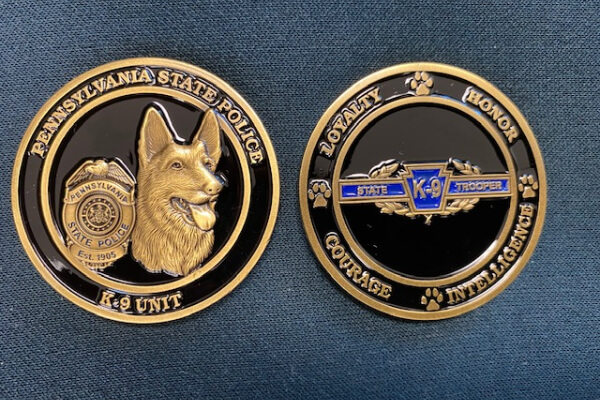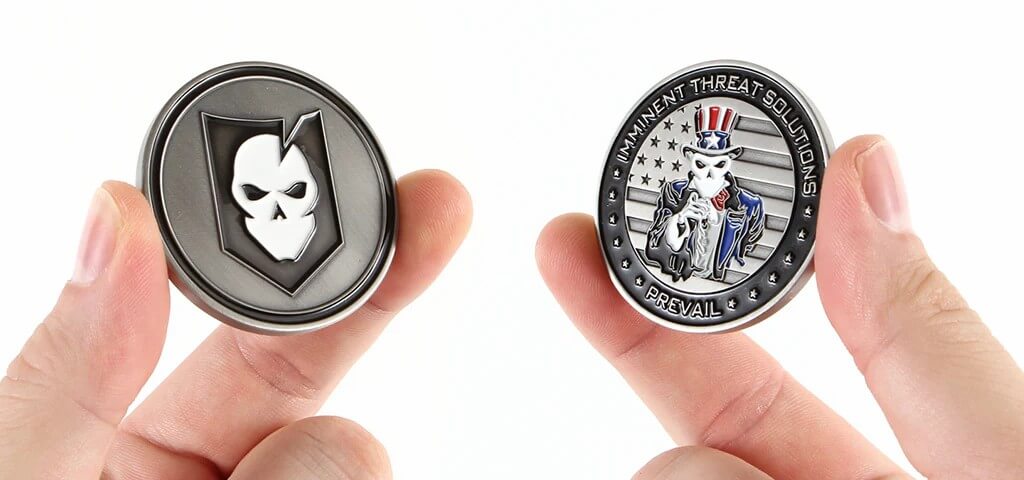Challenge coins have been a popular military tradition for over 100 years. Soldiers carried coins with them to represent their unit and its history. These coins were also exchanged among soldiers as a sign of goodwill. Made of metal, plastic, or clay, these coins can be customized to include emblems or slogans. They can be bought in bulk for about $2 per coin, but custom designs can cost more.
1. What is the Challenge Coin?
Challenge coins are small coins that can be carried with you at all times. The tokens, used to identify and enter restricted areas, are typically issued by the military, police departments, fire departments, and other public safety agencies. The challenge coin has no real monetary value, but it can serve as an important guarantee for the holder to gain access to certain locations or special privileges within a company or organization.
(Another related post: An Ultimate Guide to Customization of Challenge Coins)
2. What is the Use of Challenge Coin?
The first use of challenge coins was in the military as a badge of a unit or soldier’s role in the group, giving them access to many important locations. A soldier promoted from private to sergeant will receive an eagle-shaped shield that they can carry with them. They will also receive a challenge coin with their location’s logo on one side and their unit number on the other. Soldiers would then hand the coins to those who served with them so they could use the badge to gain access to assigned locations.
Challenge coins were discovered over time by most military branches and were used as a way of identifying members who had earned their rank, but also as a motivational tool. They usually carry a logo representing the member’s goals or a unit they are proud of.
(Another related post: A Complete Guide to Custom Keychains)
3. How Do You Determine the Proper Size for Your Particular Challenge Coin Set?
A challenge coin’s design determines its size. Therefore, it is best to plan your design before deciding on the size. Some manufacturers may require you to select a size before the design is finalized. Avoid doing this as the size will ruin your design. The size of your coin will depend on the level of detail in your design.
Your manufacturer will determine your sizing options. Some may only produce coins at specific intervals, such as 1″, 1.5″, and 2″. Other companies produce coins in various sizes, from 0.5″ to 2.5″. Other manufacturers may challenge your coin size No limit. If you’ve started working with a maker, be aware of their limitations.
If you don’t already have a maker, research their various sizing options before making a decision. The size of the coin depends on the size of the person receiving it need and taste. For example, if you are offering it as a reward for someone’s service, you may want to give them a larger one so they can display it in their home office with other rewards. However, if you will give it to someone to thank you for your help at a company event, then you might want to give them a smaller one so they can put it in their pocket or purse and carry it with them.
1) Small Detail Coin Design
A design with less detail can be smaller than a design with more detail. When your design includes larger shapes and designs, smaller coins will suffice. This is because larger shapes are easier to see and require less space. If your design is simple and clear, consider using a size smaller than 1.5″.
(Another related post: A FAQ Guide for Manufacturing and Selling of Enamel Pins )
2) Heavy Detail Coin Design
Designs with a lot of detail require larger pin sizes. That’s why standard challenge coins are about 1.5 inches in diameter. Measuring 1.5 inches in diameter, the coin captures intricate details with ease. Lots of detail in the artwork including gradient lines, grain lines, and subtle parts. For designs with lots of detail, don’t make pins smaller than 1.5 inches.
You can choose coins that are as large as 2 inches for best results. However, in most cases, pins larger than 2 inches won’t help you show more detail. Pushpins larger than 2 inches are more for aesthetics or for a specific purpose than to capture detail.
4. Why Should You Hire A Professional Designer to Customize Challenge Coins?
Custom challenge coins are a great way to reward and recognize your staff. They are also a great way to promote your company’s brand. But you need a professional designer to do them justice. Custom Challenge Coins are a reward used to recognize achievement or as an incentive for continued success. They are often used by organizations and companies as a thank-you to their employees, volunteers, members, and other stakeholders.
The coin’s design is usually designed by the organization or company that will issue it and can be customized with the recipient’s name, logo, slogan, or other information. This makes them a great marketing tool for companies, as they can be given as promotional items or gifts at trade shows or conferences to customers who buy products from the company.
For example, I have a friend. He is a switchgear supplier. Their company’s products go to exhibitions all over the world every year. Before attending the show, he orders a batch of challenge coins with the company logo. These challenge coins were given as promotional gifts at the show to each customer who came to customize the switchgear. This method will not only make customers happy but also help to expand the company’s publicity.
(Another related post: What are the 7 Key Tips for Selecting An Enamel Pin Manufacturer )
5. How to Make Your Own Custom Challenge Coin Design?
Custom challenge coins can be made in 3 easy steps:
1) Select the coin size you want to make
2) Choose the coin shape you want to make
3) Choose a badge or logo that represents you or your organization.
6. Budget for Different-sized Challenge Coins
You should always consider your budget when choosing a challenge coin. It’s simple; small coins are cheaper than larger coins. The price difference between smaller coins such as 0.25 inches and 1 inch is not significant. However, the price difference between 1″ and 2″ is much greater. Making bigger pins is always more expensive because more metal and paint is required. If you’re on a tight budget, you may want to use smaller pins with fewer details.
(Another related post: What is the Price of Medals in China? )
7. Conclusion
The purpose of this article is to provide a better understanding of the modern challenge coin, its history, and its significance. With the right tips, choosing the right size is easy. Here’s everything you need to know about choosing the best size for your challenge coin.
How useful was this post?
Click on a star to rate it!
Average rating 4.7 / 5. Vote count: 3
No votes so far! Be the first to rate this post.









